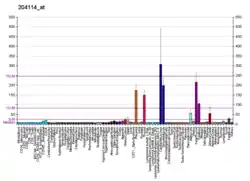Nidogen-2
Nidogen-2, also known as osteonidogen, is a basal lamina protein of the nidogen family. It was the second nidogen to be described after nidogen-1 (entactin). Both play key roles during late embryonic development.[5] In humans it is encoded by the NID2 gene.[6][7]
References
- GRCh38: Ensembl release 89: ENSG00000087303 - Ensembl, May 2017
- GRCm38: Ensembl release 89: ENSMUSG00000021806 - Ensembl, May 2017
- "Human PubMed Reference:". National Center for Biotechnology Information, U.S. National Library of Medicine.
- "Mouse PubMed Reference:". National Center for Biotechnology Information, U.S. National Library of Medicine.
- Miosge N, Holzhausen S, Zelent C, Sprysch P, Herken R (2002). "Nidogen-1 and nidogen-2 are found in basement membranes during human embryonic development". The Histochemical Journal. 33 (9–10): 523–30. doi:10.1023/A:1014995523521. PMID 12005023.
- Kohfeldt E, Sasaki T, Göhring W, Timpl R (Sep 1998). "Nidogen-2: a new basement membrane protein with diverse binding properties". Journal of Molecular Biology. 282 (1): 99–109. doi:10.1006/jmbi.1998.2004. PMID 9733643.
- "Entrez Gene: NID2 nidogen 2 (osteonidogen)".
Further reading
- Ulazzi L, Sabbioni S, Miotto E, Veronese A, Angusti A, Gafà R, Manfredini S, Farinati F, Sasaki T, Lanza G, Negrini M (2007). "Nidogen 1 and 2 gene promoters are aberrantly methylated in human gastrointestinal cancer". Molecular Cancer. 6 (1): 17. doi:10.1186/1476-4598-6-17. PMC 1831485. PMID 17328794.
- Nischt R, Schmidt C, Mirancea N, Baranowsky A, Mokkapati S, Smyth N, Woenne EC, Stark HJ, Boukamp P, Breitkreutz D (Mar 2007). "Lack of nidogen-1 and -2 prevents basement membrane assembly in skin-organotypic coculture". The Journal of Investigative Dermatology. 127 (3): 545–54. doi:10.1038/sj.jid.5700562. PMID 17008882.
- Rual JF, Venkatesan K, Hao T, Hirozane-Kishikawa T, Dricot A, Li N, Berriz GF, Gibbons FD, Dreze M, Ayivi-Guedehoussou N, Klitgord N, Simon C, Boxem M, Milstein S, Rosenberg J, Goldberg DS, Zhang LV, Wong SL, Franklin G, Li S, Albala JS, Lim J, Fraughton C, Llamosas E, Cevik S, Bex C, Lamesch P, Sikorski RS, Vandenhaute J, Zoghbi HY, Smolyar A, Bosak S, Sequerra R, Doucette-Stamm L, Cusick ME, Hill DE, Roth FP, Vidal M (Oct 2005). "Towards a proteome-scale map of the human protein-protein interaction network". Nature. 437 (7062): 1173–8. doi:10.1038/nature04209. PMID 16189514.
- Miosge N, Sasaki T, Timpl R (Nov 2002). "Evidence of nidogen-2 compensation for nidogen-1 deficiency in transgenic mice". Matrix Biology. 21 (7): 611–21. doi:10.1016/S0945-053X(02)00070-7. PMID 12475645.
- Tu H, Sasaki T, Snellman A, Göhring W, Pirilä P, Timpl R, Pihlajaniemi T (Jun 2002). "The type XIII collagen ectodomain is a 150-nm rod and capable of binding to fibronectin, nidogen-2, perlecan, and heparin". The Journal of Biological Chemistry. 277 (25): 23092–9. doi:10.1074/jbc.M107583200. PMID 11956183.
- Sasaki T, Göhring W, Mann K, Brakebusch C, Yamada Y, Fässler R, Timpl R (Dec 2001). "Short arm region of laminin-5 gamma2 chain: structure, mechanism of processing and binding to heparin and proteins". Journal of Molecular Biology. 314 (4): 751–63. doi:10.1006/jmbi.2001.5176. PMID 11733994.
- Sasaki T, Göhring W, Miosge N, Abrams WR, Rosenbloom J, Timpl R (Oct 1999). "Tropoelastin binding to fibulins, nidogen-2 and other extracellular matrix proteins". FEBS Letters. 460 (2): 280–4. doi:10.1016/S0014-5793(99)01362-9. PMID 10544250.
- Bonaldo MF, Lennon G, Soares MB (Sep 1996). "Normalization and subtraction: two approaches to facilitate gene discovery". Genome Research. 6 (9): 791–806. doi:10.1101/gr.6.9.791. PMID 8889548.
This article is issued from Wikipedia. The text is licensed under Creative Commons - Attribution - Sharealike. Additional terms may apply for the media files.




